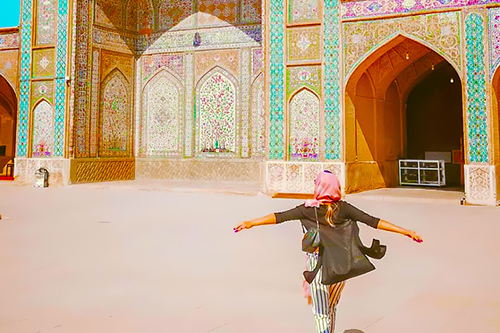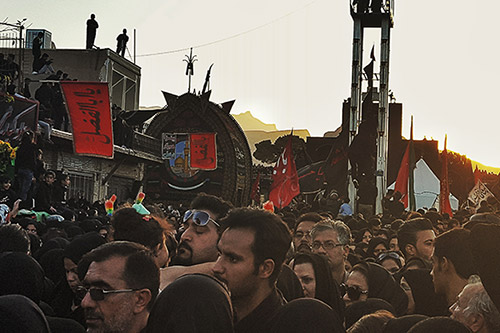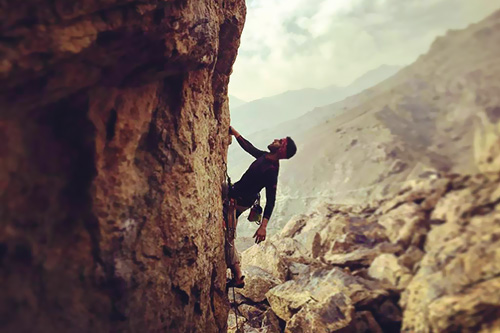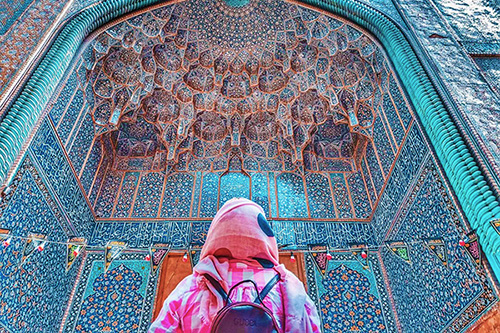 Signin with Google
Signin with Google Signin with Facebook
Signin with Facebook About Iran
About IranTop Things to Do in Tehran

During their journey to Iran, lots of visitors tend to skip Tehran or spend only a little time in Iran's capital. What a pity! It's true that the city is huge and its traffic Is often crowded. However, it has plenty of jewels to offer, from palaces to colourful bazaars, rich museums, parks, and snowy mountains. Follow the guide into a city full of life and hidden gems.
Golestan Palace, a showcase of Iranian's artwork
The Golestan Palace is the oldest historical building of the capital city of Iran and has 400 years of history. Built under the Safavid Dynasty, it's a blend of Iranian and European architecture, displaying the best of Persian artwork: colourful tilework, stunning mirrors walls and ceilings, sculpted stuccos, woodcarvings, porcelains. Visitors can spend a day discovering the wonders of the 17 historical buildings of this palatial ensemble. It bears the memories of the lavish ceremonies organized by the Qajar and then Pahlavi kings, the two last dynasties. Inside the frenzied capital, its delicate Persian garden is a nice place to rest and admire the grandeur of the Persian Empires.
Sa'dabad Museum Complex, a nest of greenery for palaces
When the Qajar kings started to build this palatial complex almost 100 years ago, they choose to settle their summer residence at the foot of the mountains, in a quiet and unspoiled natural scenery. Nowadays, the city has reached the doorstep of Sa'dabad Palace, but this latter has kept an incredibly peaceful atmosphere. 18 historical buildings spread over the 110 hectares of the complex which, besides the places and museums, offer a pleasant walk into a natural forest. The Green Palace and White Palace are the pinnacles of the visit, the latter showing the extravaganza of the late Qajar kings, with more than 54 rooms lavishly decorated with gifts from European leaders.
The colourful Grand Bazaar and Tajrish Bazaar
A trip to Iran cannot be complete without wandering into the picturesque alleys of its bazaars. In the heart of the city, the 200 years old Grand Bazaar illustrates the animation of these places, which are way more than shopping centres. They are the economic heartbeat of the country, a place where anything can be found and where people of all social origins meet. The best way to visit the bazaar is to get lost into the maze of its alleys, going from the stalls of spices to the carpets shops and copper section. In between, have a break in the impressive Imam Khomeini Mosque and the peaceful Imamzadeh Zeid. In the north of Tehran, Tajrish Bazaar is another must-see bazaar in Iran, smaller and more elegant, with a unique atmosphere.
Niavaran Palace Complex, from the Qajar to the last king of Iran
Located in the north of Tehran, Niavaran Palace was built in the late 18th century, but the Qajar kings for their summer residence, before becoming the residence of the imperial family of the last king of Iran, Mohammad Reza Shah. The Niavaran mansion is a European style building, surrounded by a pleasant garden and old trees. Inside the other pavilions are nowadays several museums, as well as a valuable private library containing more than 23000 books mostly in Persian and French.
The gems of Tehran’s museums
The city capital has many treasures to share inside its museums. Whether you're into history or modern arts, there is a museum for you in Tehran. Among the most famous is the Treasury of National Jewels, which hold an invaluable collection of gemstones: crowns, thrones, jewels, and other adornments of the Safavid, Qajar and Pahlavi kings and queens recall the greatness of these empires. Don't miss the stunning "Peacock Throne", as well as the largest uncut diamond in the world, of 182 carats. To discover the great history of Persia in-depth, visit the National Museum of Iran. This historical building possesses a precious collection of archaeological findings, as well as the most precious Islamic arts from calligraphy to carpets. If you're looking for something modern, the Museum of Contemporary Arts has an impressive collection of more than 3000 pieces of art, from Iranian and European artists such as Picasso, Matisse, Van Gogh, etc.
Milad Tower, the modern symbol of Tehran
It is impossible to miss it: Borj-e Milad is visible from almost every part of the city, as it is the tallest structure of Tehran, and also, the sixth-tallest tower in the world. Inaugurated in 2009, the modern and elegant tower is a large complex with a five-star hotel, a restaurant, and a convention centre. Its main attraction for visitors is the 360° view offered at its top: a breathtaking panorama with snow-capped mountains at the horizon, which makes you realize the hugeness of this megacity.
Tabiat Bridge, where modernity and nature unite
Most stunning at night with its changing lighting colours, the Tabiat Bridge (“nature” in Persian) is one of the most beautiful modern structures of the capital. Constructed in 2010, this stunning architectural creation has won several awards and is the largest pedestrian overpass in Tehran. Crossing the always crowded Modarress highway, it connects two public parks, Taleghani Park and Abo-Atash Park. On 270 meters, visitors can walk on two platforms and appreciate a unique view over the mountains on one side, and the city on the other side. It's a pleasant place to simply chill out among the Tehranis who come here to spend time together and have picnics.
Darband, a relaxing escape at the foot of the mountain
Formerly a small village close to Tajrish Square, Darband is located at the footstep of the mountains as indicated by its Persian name (literally, "The Door to the Mountain"). It's the beginning of hiking trails into Mount Tochal, and also a pleasant destination to enjoy its unique atmosphere. Very popular, Tehranis come to Darband mostly in the evenings to enjoy its numerous cafes and restaurants, located all along the cascading water coming directly from the mountain, while buying dried fruits and "lavashak", a typical Iranian sour fruit roll.
Reach Mount Tochal and enjoy skiing in Tehran
Lots of people know about Iran’s gorgeous deserts, but few of them imagine that in winter, one-third of the country is covered by snow! And there is no need to go out of the capital to enjoy a ride into the purest snow powder: Mount Tochal which rise at 3933 meters is easily accessible via a Telecabin. It offers a pleasant journey with a stunning view, before reaching the Tochal Ski Resort, a paradise for ski lovers and snowboarders. For more than half of the year, it's possible to ski in the capital. During summer, mountain lovers come here to enjoy a hike on top of one of the many summits of this part of the Alborz Range.
Chitgar Lake, sail away from the city
If you want to have a break from the tumult of the city, head toward the northwest of Tehran to discover Chitgar Lake. Also known as the Persian Gulf Lake, this artificial lake has been created recently to offer a pleasant recreational area. Visitors can walk along the lake, which covers an area of 130 hectares, and simply enjoy the beautiful view. If you're looking for some fun and exercise, rent a bike, paddle a boat on the lake, or choose any of your favourite activities in the recreational harbour. And when you're tired, just remove your shoes and sit on the rocky beach to admire the sunset, before pampering yourself with a good restaurant.
Imamzadeh Saleh, the delicate shrine of northern Tehran
Located near the Tajrish Bazaar, this splendid mosque with its delicate blue dome and minarets is a popular shrine of northern Tehran. Of modest scale, this mausoleum is the resting place of Saleh, the son of the seventh Shia Imam. With the beautiful mountains of the Alborz Range in the background, the Imamzadeh is a showcase of the finest Islamic architecture and Persian artwork, from the tilework of its courtyard to the dazzling mirror of its interior.
Azadi Tower, Tehran's most famous landmark
Visiting Tehran without seeing the Azadi Tower, is like going to Paris and missing the Eiffel Tower. Built under the last king of Iran, Mohammad Reza Pahlavi, this tower, whose name means "Freedom", has become the symbol of the Iranian's capital. This famous landmark was built in the late 1960s to commemorate the 2500th year of the foundation of the imperial state of Iran with Cyrus the Great. The snow-white marble structure is a masterpiece incorporating Achaemenian, Sassanian and Islamic architectures. It stands in the middle of a pleasant square and hosts a museum while offering a stunning view of the city and the Alborz Range Mountains.
The US Den of Espionage, enter the former American embassy
The former US embassy is a monument of history, as it is where took place the Iran hostage crisis in 1979, a main event of the Islamic Revolution. 52 American diplomats and citizens were held captive by students for 444 days in an action aimed to protest against the spying of US government in Iran. Nowadays, the exterior of the building is decorated with iconic paintings of propaganda against the US government. Inside, it has been turned into a museum that recalls this event and the interference of Americans on Iran’s soil. It is a fascinating visit, during which can be observed old-fashioned telex machine and computers used by the diplomats at that time.
In the green nests of Tehran’s parks
Tehran has preserved many green areas which constitute a true oasis in the uproar of the city. During weekends, Tehranis love to go there, in order to sit on carpets and share a family picnic outdoors. Among the most famous green areas is Mellat Park, Tehran's version of Central Park: a wide peaceful natural refuge located in the north of the city, and full of elegant crows and chilling cats. The quiet waters of its small lake come directly from the neighbouring Mount Tochal. Further in the northeast of the city is Jamshidieh Park, the Stone Garden. Standing at the very foot of the mountain, it offers a stunning view of the city, for those who are brave enough to climb its shady alleys. It's the favourite destination for hikers who can climb up the mountainside from there. Located at the very heart of the city, Laleh Park is another natural escape from the city. The numerous beautiful sculptures are a reminder of the presence of the Modern Museum located inside the Park.




